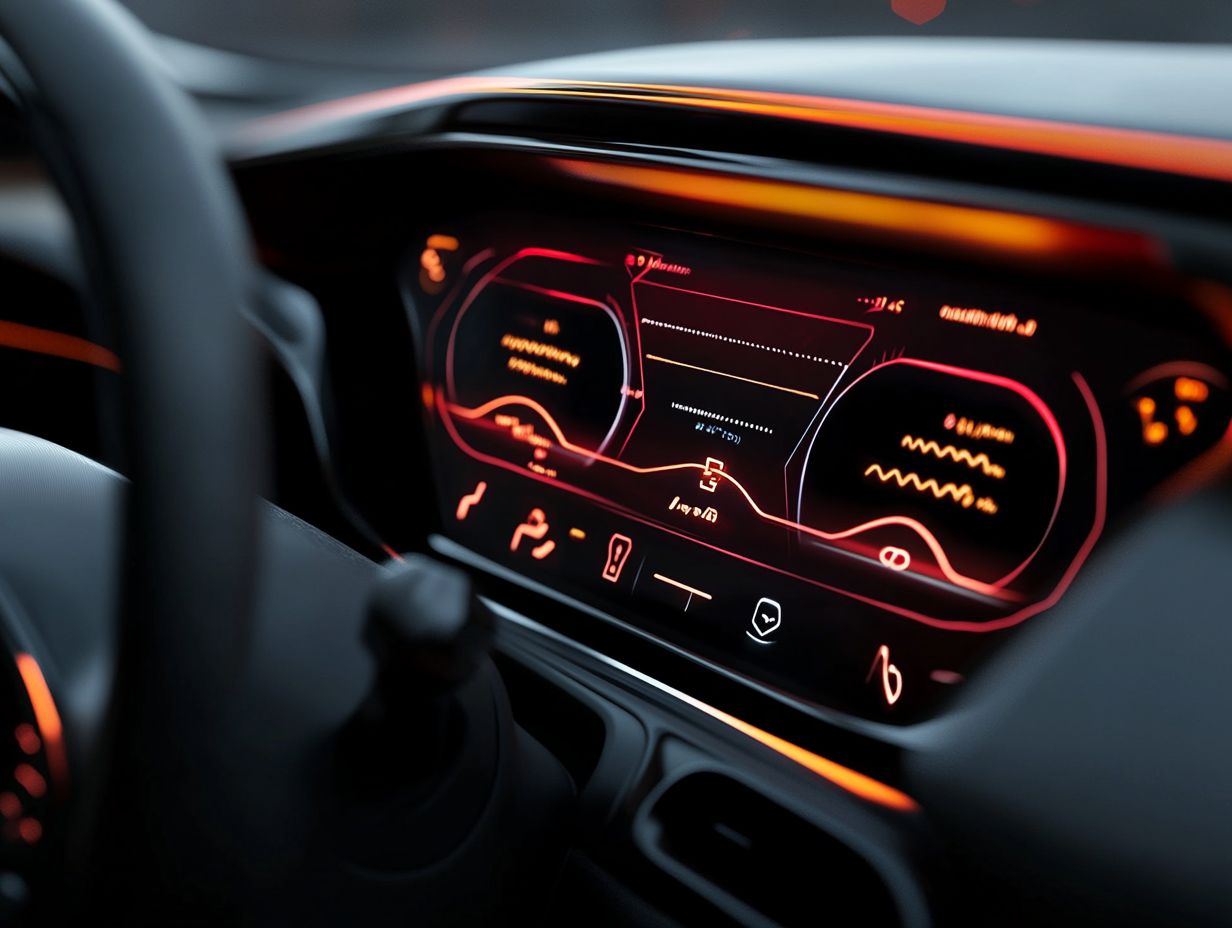New Car Safety Ratings: What to Look For
When it comes to purchasing a new car, safety should be at the forefront of your decision-making! Navigating through car safety ratings might seem daunting, but it’s crucial for ensuring that you select a vehicle that keeps you and your loved ones secure on the road.
This article will clarify what safety ratings mean, delve into common safety features found in modern cars, and offer practical tips for effectively interpreting these ratings. Additionally, it will highlight key factors to consider when choosing the safest car tailored to your needs and provide valuable insights on safe driving and maintenance practices.
Your journey toward a safer driving experience begins right here.
Contents
- Key Takeaways:
- Understanding Car Safety Ratings
- Common Safety Features in New Cars
- How to Interpret Safety Ratings
- Choosing the Safest Car for You
- Staying Safe on the Road
- Frequently Asked Questions
- What are new car safety ratings and why should I care?
- What factors are considered when determining a car’s safety rating?
- How do I know which new car safety ratings to trust?
- What is the difference between a five-star and a four-star safety rating?
- Should I base my car purchase solely on safety ratings?
- Can I improve a car’s safety ratings?
Key Takeaways:

Look for cars with high safety ratings, including top scores in crash test performance and new car safety features like airbags, seat belts, and electronic stability control.
When considering safety ratings, pay attention to the specific factors evaluated, such as crash avoidance and mitigation, and how they align with your priorities and needs.
Don’t compromise on safety! Remember that your driving habits and maintenance practices also play a crucial role in your safety on the road. Always practice safe driving techniques and regularly maintain your vehicle to ensure optimal safety.
Understanding Car Safety Ratings
Grasping the nuances of car safety ratings is essential for you as a consumer when selecting a vehicle. These ratings, along with user ratings of cars with advanced safety features, offer a clear picture of the overall safety performance of passenger cars, SUVs, and pickup trucks, shedding light on their crash protection and rollover safety.
Renowned organizations like the NHTSA employ a thorough safety ratings program, prominently featuring the NHTSA 5-Star Safety Ratings. This program assesses vehicles through a series of detailed tests designed to see how well cars hold up in a crash and evaluates their safety technology features, enabling you to make informed choices about your vehicle purchases.
What Do the Ratings Mean?
The various vehicle safety ratings, such as the NHTSA 5-Star Safety Ratings, provide you with essential insights into a vehicle’s ability to protect you in a crash. These ratings highlight crucial aspects like the overall frontal star rating and side crash rating results, which are vital as you contemplate safety in your transportation choices.
These ratings are derived from rigorous testing protocols designed to determine how well vehicles withstand impacts during collisions. Frontal crash tests simulate head-on crashes, measuring potential harm to occupants, while side crash tests assess a vehicle’s ability to protect against lateral impacts an often-overlooked factor that can significantly affect injury outcomes.
The implications of these ratings are significant. Higher side crash ratings indicate stronger structural integrity, which can substantially reduce the risk of serious injury in side collisions. Therefore, you can rely on these evaluations to make informed decisions, prioritizing models that boast enhanced safety features and superior protection for passengers. This ultimately influences your purchasing decisions and peace of mind on the road.
Common Safety Features in New Cars
Common safety features in new cars are meticulously designed to reduce the risk of serious injury during accidents while enhancing overall vehicle safety. These advanced technological innovations include crash protection, rollover safety, and Rear Crash Prevention systems, all seamlessly integrated for your peace of mind.
They also prioritize ease of use in car seats, making it simple to ensure that everyone is securely positioned. With these enhancements, modern vehicles strive to create a safer environment for all passengers, effectively equipped to handle a variety of crash scenarios.
As you begin your car shopping journey, make sure to research cars with high safety ratings to ensure peace of mind on the road!
Types of Safety Features

The types of safety features in vehicles are incredibly diverse. They range from passive systems like airbags to advanced active safety technologies, which are systems that help prevent accidents, such as crash protection, rollover safety, and Rear Crash Prevention. These elements play crucial roles in the vehicle safety ratings established by organizations like IIHS.
Active systems assist in preventing accidents with technologies like anti-lock braking systems (ABS) and lane departure warning systems, which alert you when you unintentionally drift from your lane. On the other hand, passive systems focus on protecting you and your passengers after a collision occurs. Seat belts secure occupants, while crumple zones are engineered to absorb impact energy, minimizing injury.
Both categories significantly enhance a vehicle’s overall safety profile and affect compliance with IIHS ratings. By integrating these features, manufacturers not only bolster safety but also foster greater confidence in their vehicles among consumers.
How to Interpret Safety Ratings
Interpreting safety ratings from various programs requires awareness of the overall Vehicle Score. This score includes results from side barrier crash tests and additional assessments.
Recognize safety concern symbols that highlight potential risks tied to specific vehicle models. Armed with this knowledge, you can quickly navigate the vital world of vehicle safety ratings, making informed decisions that prioritize your safety and well-being.
Factors to Consider in Rating Systems
When assessing the factors that influence rating systems, it s essential to grasp the methodologies used by organizations like NHTSA and IIHS. These methodologies can significantly shape the outcomes of safety ratings programs and ultimately impact your decisions regarding vehicle purchases.
The testing processes employed by these agencies typically involve rigorous crash tests, evaluations of safety features, and analysis of real-world accident data. Each organization may have its own distinct criteria for assessing airbags, seatbelt effectiveness, and structural integrity. These criteria contribute to a vehicle’s overall safety score.
These differing methodologies can lead to varying ratings, affecting consumer perceptions and trust. For example, a vehicle might achieve a high rating from one organization while receiving a lower score from another. This prompts you to carefully consider these ratings before making a purchase.
In today’s car market, being an informed buyer is crucial to your safety!
Choosing the Safest Car for You
Selecting the safest car for yourself requires thoughtful evaluation of vehicle safety ratings and accolades, like the esteemed Top Safety Pick and Top Safety Pick Plus. These distinctions showcase vehicles that excel in crash tests and incorporate advanced safety technology.
Consider your personal safety concerns and individual needs to ensure you make a thoroughly informed decision.
Factors to Consider in Your Decision

When choosing your next vehicle, several key factors deserve your attention. Start by understanding the safety ratings program and evaluating the vehicle safety ratings, balancing features with your budget and personal preferences.
Consider how the vehicle will integrate into your lifestyle. If you have a growing family, spacious seating and ample cargo capacity are non-negotiable. On the other hand, if you re navigating the urban jungle, you ll likely prioritize fuel efficiency and a compact design that makes parking a breeze.
It s also prudent to explore available safety features, such as advanced driver-assistance systems, which can significantly enhance your peace of mind.
By aligning your personal criteria with practical considerations like financing options and maintenance costs, you can make a well-informed choice that meets your immediate needs and fulfills your long-term expectations.
Staying Safe on the Road
Staying safe on the road requires a thoughtful blend of leveraging modern safety technologies, following essential safe driving tips, and maintaining your vehicle in top condition. Each of these elements plays a crucial role in enhancing crash protection and ensuring reliable vehicle safety ratings.
Tips for Safe Driving and Maintenance
Implementing safe driving tips and committing to regular vehicle maintenance significantly boosts your crash protection. This commitment ensures that your safety technology features are operating at their best, ultimately enhancing overall road safety.
By adhering to safe driving practices like keeping a safe following distance and obeying speed limits you can effectively reduce the likelihood of collisions. Stay alert! Utilize turn signals and be vigilant about your blind spots to prevent accidents.
Routine maintenance tasks can dramatically enhance your vehicle’s performance. Check your tire pressure, replace worn brake pads, and ensure your headlights are functioning properly. These conscientious efforts protect you and your passengers from potential harm and extend the longevity and reliability of your vehicle.
This proactive approach creates a safer driving environment for everyone on the road.
Frequently Asked Questions
What are new car safety ratings and why should I care?

New car safety ratings refer to the safety scores and evaluations given to vehicles by organizations such as the National Highway Traffic Safety Administration (NHTSA) and the Insurance Institute for Highway Safety (IIHS). These ratings provide valuable information about a vehicle’s safety features and how well it protects its occupants in a collision. When purchasing a new car, consider the safety features to look for in family cars to help make an informed decision.
What factors are considered when determining a car’s safety rating?
Both the NHTSA and IIHS take into account various factors when assigning safety ratings to a car. These include crash test results, safety features such as airbags and seat belts, and safety features like automatic emergency braking and lane departure warning systems.
How do I know which new car safety ratings to trust?
Look for safety ratings from reputable organizations such as the NHTSA and IIHS. These organizations have strict testing protocols and are recognized as reliable sources for evaluating vehicle safety. You can also check for recalls or safety concerns on a specific make and model through the NHTSA’s website.
What is the difference between a five-star and a four-star safety rating?
The NHTSA uses a five-star rating system, with five stars being the highest rating a vehicle can receive for overall safety. A four-star rating indicates that the vehicle has performed well in crash tests but may have some areas for improvement. A four-star rating is still considered a good safety rating.
Should I base my car purchase solely on safety ratings?
While safety ratings are important, they should not be the only factor in your car purchase decision. Consider your specific needs and preferences, such as fuel efficiency, budget, and style. Finding a balance between safety ratings and other factors is vital in selecting the best car for you.
Can I improve a car’s safety ratings?
While you can’t change the ratings assigned by the NHTSA or IIHS, you can improve a vehicle’s overall safety by choosing models with advanced safety features and by properly maintaining your car. Regularly check and replace worn-out parts, such as tires and brakes, to enhance a car’s safety performance.
Stay informed and proactive about your vehicle safety. Share your experiences or questions related to car safety!






